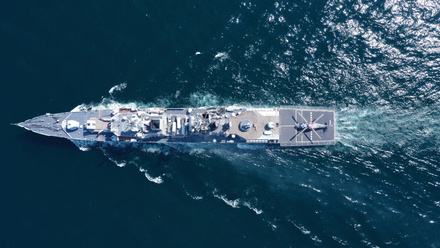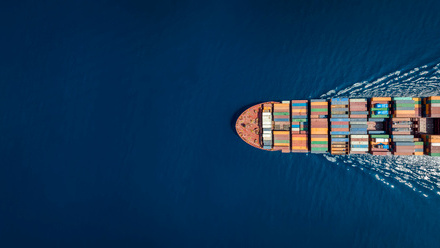Presenters:
Students from Stevens Institute of Technology, SUNY Maritime College, U.S. Merchant Marine Academy, and Webb Institute
Timings:
| Social Hour | 5:00 PM |
| Dinner | 5:30 PM |
| Campus Tour | 6:30 PM |
| Technical Session & Webcast | 7:00 PM |
Papers:
Comparative Design Study of a Polar Research Icebreaking Vessel
Michael Monteleone, Cora Scolaro, Cleo Shannon, and Peter Zmijewski
Abstract:
A study of performance efficiency was conducted under mission-specific conditions to determine whether the two-pod or three-pod propulsion system was more efficient for an icebreaking vessel. Both vessels were designed as similar as possible to ensure a controlled comparison. The primary structural difference lies in the bow design: the two-pod vessel featured a conventional icebreaking bow, compared to the three-pod vessel which accommodates a forward, centerline pod. To isolate the effects of pod configuration, the power generation systems, superstructures, and internal structures were identical. To determine their comparable hydrodynamic performances, reduced-scale models of both ships will be built and tested in the Davidson Laboratory Towing Tank. The first test focused on evaluating the resistance and stability of both vessels in calm water and waves, and the second to qualitatively assess maneuverability capabilities the introduction of simulated ice obstacles in the tank. Additionally, a business model was developed around these vessels being charterable, with the goal of promoting the progress of scientific research and exploration of the Antarctic region. A focus was placed on providing an adaptable research space for independent organizations specializing in biological, geophysical, chemical, and sociocultural processes of the Antarctic while minimizing environmental impact by optimizing fuel efficiency.
About the authors:
Michael Monteleone is an undergraduate student at Stevens Institute of Technology, pursuing a degree in Naval Engineering, with an expected graduation in May 2025. He has gained hands-on industry experience through internships in hydrodynamics engineering at General Dynamics Electric Boat and naval architecture at Chesapeake Shipbuilding. After earning his degree, Michael will join Chesapeake Shipbuilding as a full-time Naval Architect.
Cora Scolaro is an undergraduate student at Stevens Institute of Technology, pursuing a Bachelor of Engineering in Naval Engineering, with an expected completion in May 2025. After earning her degree, she plans on working towards a Master of Engineering studying Ocean Engineering at Stevens. She has gained hands-on experience working as a technician at Davidson Laboratory for two and a half years, assisting in numerous model tests. She is an inducted member of the engineering honors society Tau Beta Pi, a recognition for being an exceptional engineering student with exemplary character. She has interests in working on research ships and sustainable designs.
Cleo Shannon is an undergraduate student at Stevens Institute of Technology, pursuing a Bachelor of Engineering in Naval Engineering with an expected graduation in May 2025. She has gained industry experience as a Naval Architecture intern at Naval Surface Warfare Center, Carderock and as a Project Engineer intern with Marine Solutions. Additionally, she has been a researcher in the Coastal Engineering department at Stevens for two years, studying dams, levees, and wave patterns to contribute to better shoreline recession predictions. After earning her degree, she will pursue a Master of Engineering in Engineering Management while working as a Naval Architect for Newport News Shipbuilding.
Peter Zmijewski is an undergraduate student at Stevens Institute of Technology and is set to graduate with a degree in Naval Engineering in May 2025. He has gained industry experience through his time interning with Release Boatworks and Viking Yachts, while also designing and building three of his own wooden boats. Peter has worked in Davidson Lab over the past year and a half and is interested in the design of yachts and high-speed craft.
Electric RoPax Catamaran Ferry Design
Mark Antal, Christopher Chu, and Fanourios Tsatalios
Abstract:
The Hellenic government has made an official request to UNESCO and the European Union for the creation of marine parks in the Aegean and Ionian Seas, thus enforcing the utilization of green technology to protect the marine ecosystem. As such, a ship owner requests a fleet of fully electric Ro-Pax catamaran ferries to replace older heavy fuel oil or diesel-only operated vessels. Many different types of passenger designs were developed in response to this statement and the final design was chosen to be an all-electric catamaran plan. The design comes with technology that will make it stand out from the competition including and not limited to autonomous battery swapping, electric telescopic charging, and many more.
About the authors:
From Severna Park, Maryland, Mark D. Antal is a first gen naval architect graduate (Spring 2025) in his family with a job lined up at Newport News Shipbuilding in aircraft carrier development. Complemented with a background in powerboat maintenance/construction, as well as hull modeling from previous internships and job opportunities, Mark loves to surround himself in the shipbuilding community and learn from hands-on experiences. Favorite pastimes include boating/fishing in the Magothy River, cricket and other sports, and volunteering in his hometown community. Mark has been a part of many ship design competitions including, and not limited to, the SNAME Lisnyk competition and the Worldwide Ferry Safety Association design competition.
From Massapequa, New York, Christopher Chu aspired to be a Naval Architect since fifth grade and has a tentative offer from Norfolk Naval Shipyard. Chris has interned with Shipwright/Shipglide based out of Port Everglades helping with the installation of an air lubrication system and Fincantieri Marinette Marine assisting the Shock and Naval Architecture departments with the U.S. Navy’s new Constellation Class Frigate. The love for naval architecture started while growing up on the water driving boats and rowing for his high school crew team. Other competitions that he was involved in were the Worldwide Ferry Safety Competition and is competing in the SNAME Lisnyk competition.
Fanourios Tsatalios is an undergraduate Naval Architecture student also enrolled in the fast-track master's program of Shipping and Logistics at SUNY Maritime College. From Wayne, New Jersey, and originally raised in Athens, Greece, Fanourios wanted to be a Naval Architect since a young age. He views this industry as a combination of engineering and art, a way to express creativity and innovation through practicality. Fanourios is looking forward to graduating and being involved in the maritime industry actively, be part of its future, and contribute to the evolution of efficient and innovative ship designs. As such, the student and his teammates competed in the Worldwide Ferry Safety Association design competition, while also competing in the SNAME Lisnyk competition.
The Increasing Trend of LNG Dual Fuel Systems on Containerships
MIDN ENS Brian Son 1/C
Abstract:
As the world continues to industrialize, there are global movements that seek out alternative fuels due to increasing demand for cleaner environmental footprints. Similar to the automobile sector in its wake of battery-powered vehicles in the 2010s, the maritime industry is also subjected to environmental regulations that seek out alternative fuels to burn for commercial vessels. Historically, the maritime industry has lacked a firm foundation regarding environmental regulations at sea. However, this began to rapidly transition in the late 20th Century and into the 21st Century. As a result, the establishment of environmental regulations has significantly impacted maritime industry standards and business operations. International regulatory bodies such as the International Maritime Organization (IMO - UN) and the European Union (EU) have forged significant regulations that have protected both the marine and atmospheric environment. Under the IMO there are internal organizations such as the Marine Environmental Division, which is directed by the Marine Environment Protection Committee (MEPC). These governing bodies have established famous regulatory documents such as the International Convention for the Prevention of Pollution from Ships (MARPOL). Under MARPOL, there are Annexes that outline the different types of pollutants that are either carried or emitted by maritime vessels. In relation to this research, Annex VI focuses on limiting the air pollution that is produced by vessels at sea and in port. Under Annex VI, topics such as Emission Control Areas (ECAs) or Sulfur Emission Control Areas (SECAs) and other energy efficiency measurements are standardized and published. As a result, of these present and future policies, major transitional effects occur in sectors such as marine engineering and fuel bunkering. With the impact of these sectors, there are bound to be strong waves created in the shipping business.
About the author:
Midshipman Son grew up and was raised in Destin, Florida and he entered the Academy in 2021 seeking military fulfillment and structure. Set to graduate with a degree in Maritime Logistics & Security in 2025, he sailed over 330 active days aboard various types of commercial vessels, while conducting important military logistical missions, gaining intimate experience in maritime navigation and operations. Regimentally, he served as a department head for External Affairs as the Regimental Public Affairs Officer and as the right hand to VADM Joanna C. Nunan as the Admiral's Aide. MIDN Son was able to accomplish a series of media projects and deliver a higher level of media visibility for the Academy. He's currently planning out his post-graduation career strategy in either the Air Force Reserves or Navy Active Duty. Ultimately, he seeks to contribute to our Nation's national defense while preparing himself for a future in maritime finance or economics.
A Numerical Investigation of Titanic's Calm Water Maneuvering Characteristics
Hendrix P. Lovett
Abstract:
This research investigates the quality of Titanic’s maneuverability in calm water given the vessel’s design service speed of 22.5 knots. Investigations by the SNAME Marine Forensics Committee were expanded upon by developing a full-scale numerical analysis of the vessel’s hydrodynamic behavior within fully viscous Reynold’s Average Navier Stokes CFD captive model tests. A model of the ship’s hull was developed using computer aided design software and validated by comparing sections with the original lines plan of the Olympic Class. Hydrodynamic derivatives were obtained through regressing the results of the vessel’s planar motion in pure sway and pure yaw, and the ship’s steady turning radius was determined by integrating these values with SNAME’s flat-plate rudder data. Preliminary results indicate a sufficient level of maneuverability for the ship’s safe transit across the North Atlantic Ocean given modern-day turning standards.
About the author:
Hendrix P. Lovett is a fourth-year naval architecture and marine engineering student from Webb Institute. He is also a student member of the Marine Forensics Committee for the Society of Naval Architects and Marine Engineers. He is originally from Wichita, KS and first became interested in ships through maritime history and sailing. Throughout his time at Webb, he has interned for various companies including General Dynamics NASSCO, the Military Sealift Command, Keil Maritime, and NETSCo. Following Webb, he is excited to continue pursuing opportunities within vessel design and marine forensics.



